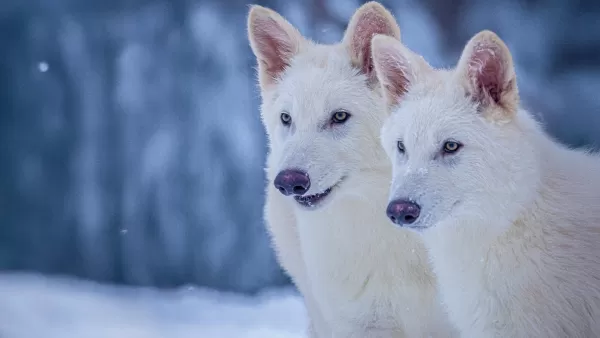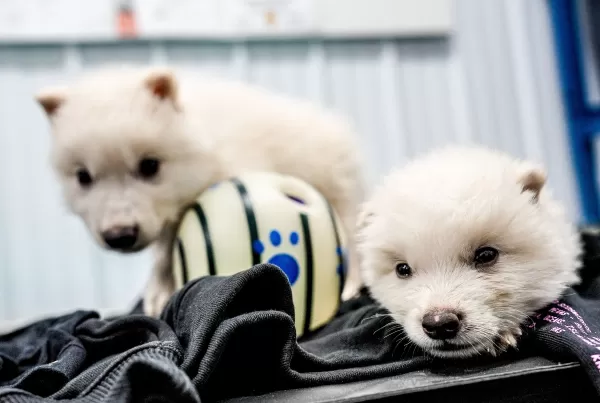"Science Revives Extinct Dire Wolves"
Bringing a super-sized canine back from extinction after 12,500 years might sound like the plot of a blockbuster movie, complete with special effects of gnawed flesh and buckets of fake intestines. However, this isn't fiction; it's reality, thanks to the biotech company Colossal Biosciences. They've successfully used the DNA of the common gray wolf, gene-editing techniques, and domestic dog surrogates to bring three dire wolves into existence: Romulus, Remus, and their younger sister, Khaleesi. These majestic creatures, residing in a secret location in the US, embody the essence of any mother of dragons' dream—huge, white, and undeniably awe-inspiring.
 Romulus and Remus at three months old
Romulus and Remus at three months old
Ben Lamm, CEO of Colossal Biosciences, expressed immense pride in his team's achievement, stating, "This massive milestone is the first of many coming examples demonstrating that our end-to-end de-extinction technology stack works." The team's innovative approach involved extracting DNA from a 13,000-year-old tooth and a 72,000-year-old skull to create healthy dire wolf puppies. Lamm reflected on the project's significance, saying, "It was once said, ‘any sufficiently advanced technology is indistinguishable from magic.’ Today, our team gets to unveil some of the magic they are working on and its broader impact on conservation."
 Romulus and Remus at one month old
Romulus and Remus at one month old
Colossal Biosciences isn't new to making headlines. They previously engineered a Colossal Woolly Mouse, resembling a mammoth in phenotype, using computational analysis of 59 woolly, Columbian, and steppe mammoth genomes. Critics argue that the dire wolves are merely normal wolves in elaborate costumes, suggesting that the remaining dire wolf DNA isn't sufficient to create a true genetic clone.
However, the company's motives extend beyond creating viral sensations and owning impressive pets. Colossal Biosciences aims to leverage its findings to aid in the preservation of current species for future generations. Dr. Christopher Mason, a scientific advisor and board member, emphasized the transformative nature of their work, stating, "The de-extinction of the dire wolf and an end-to-end system for de-extinction is transformative and heralds an entirely new era of human stewardship of life."
Mason further highlighted the broader implications of their technology, noting, "The same technologies that created the dire wolf can directly help save a variety of other endangered animals as well. This is an extraordinary technological leap in genetic engineering efforts for both science and conservation, as well as preservation of life, and a wonderful example of the power of biotechnology to protect species, both extant and extinct."
For the dire wolves, Colossal Biosciences has collaborated with the American Humane Society and the USDA to ensure their well-being at a 2,000+ acre preserve, where they are cared for by a dedicated team of staff.
- 1 Zenless Zone Zero [ZZZ] Codes (December 2024) – 1.4 Livestream Codes Feb 08,2025
- 2 Capcom Spotlight February 2025 and Monster Hunter Wilds Showcase: Everything Announced Mar 05,2025
- 3 New LEGO Sets for March 2025: Bluey, Harry Potter, and More Mar 06,2025
- 4 Gothic 1 Remake Demo: Frame-by-Frame Comparison with Original May 01,2025
- 5 Blazing Conquest: Conquer Lords Mobile on Mac with BlueStacks Air Feb 21,2025
- 6 PUBG Mobile Redeem Codes for January 2025 Live Now Feb 13,2025
- 7 "Tower of God: New World Introduces Alphine and Kaiser" Jun 28,2025
- 8 Pokémon TCG Pocket Unveils Premium Pass and Trade Tokens Apr 21,2025
-
Best Racing Games to Play Now
A total of 10
-
Top Business Management Apps for Android
A total of 10
-
Best Competitive Multiplayer Games on Android
A total of 10

















![Business of Loving [v0.12.5i] [Dead End Draws]](https://imgs.96xs.com/uploads/18/1719555107667e5423ef803.jpg)












